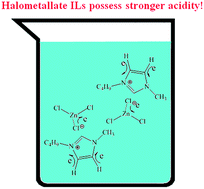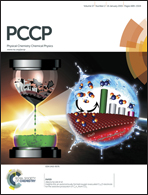The acidity/basicity of metal-containing ionic liquids: insights from surface analysis and the Fukui function†
Abstract
Metal-containing ionic liquids (ILs) have been recognized as potential solvents, catalysts, catalyst precursors and reagents for many organic processes. In this work, several quantum-chemical parameters, including the surface electrostatic potential (Vs,max and Vs,min), the lowest surface average local ionization energy (![[I with combining overline]](https://www.rsc.org/images/entities/i_char_0049_0305.gif) s,min), and the electrostatic potential at the position of an atom (EPnuc), were adopted to understand the acidity/basicity of metal-containing ILs. Chlorometallate-based ILs show stronger acidity than conventional ILs, because of the increased electron-deficiency of the imidazole ring upon the incorporation of metal chloride. For the ILs with the Ag-coordinated cations, the acidity tends to attenuate while the basicity becomes stronger, as compared to traditional ILs. In addition, the regional Fukui function was also used to assess the molecular distribution of the Lewis acidity/basicity of the ILs under study. Overall, the introduction of metals into either the cations or the anions influences the acidity/basicity of ILs to a large degree, which would be beneficial for their certain applications, such as catalysis and extraction. We hope that the results presented here will assist in the development of novel metal-containing ILs with desirable properties.
s,min), and the electrostatic potential at the position of an atom (EPnuc), were adopted to understand the acidity/basicity of metal-containing ILs. Chlorometallate-based ILs show stronger acidity than conventional ILs, because of the increased electron-deficiency of the imidazole ring upon the incorporation of metal chloride. For the ILs with the Ag-coordinated cations, the acidity tends to attenuate while the basicity becomes stronger, as compared to traditional ILs. In addition, the regional Fukui function was also used to assess the molecular distribution of the Lewis acidity/basicity of the ILs under study. Overall, the introduction of metals into either the cations or the anions influences the acidity/basicity of ILs to a large degree, which would be beneficial for their certain applications, such as catalysis and extraction. We hope that the results presented here will assist in the development of novel metal-containing ILs with desirable properties.


 Please wait while we load your content...
Please wait while we load your content...